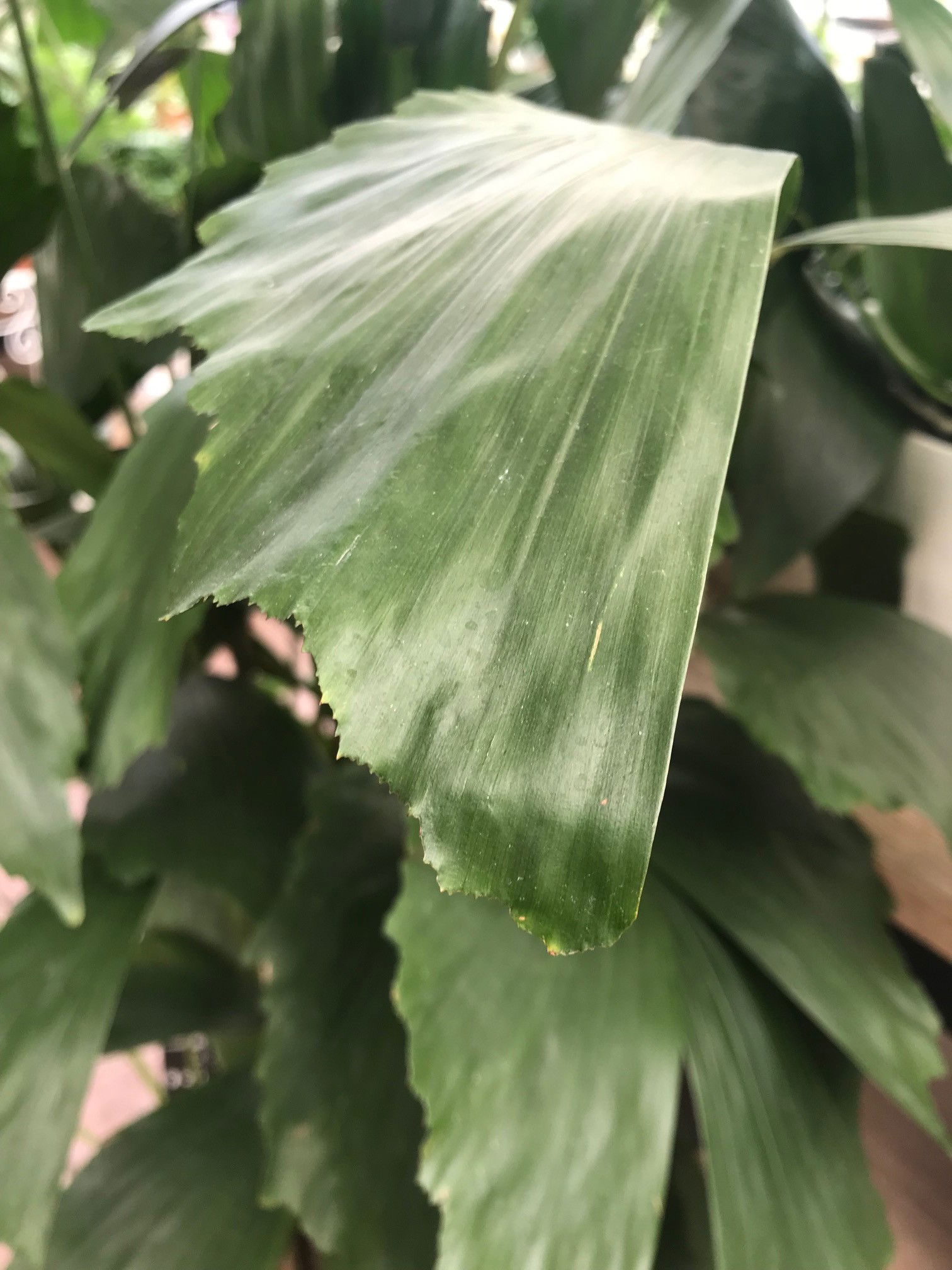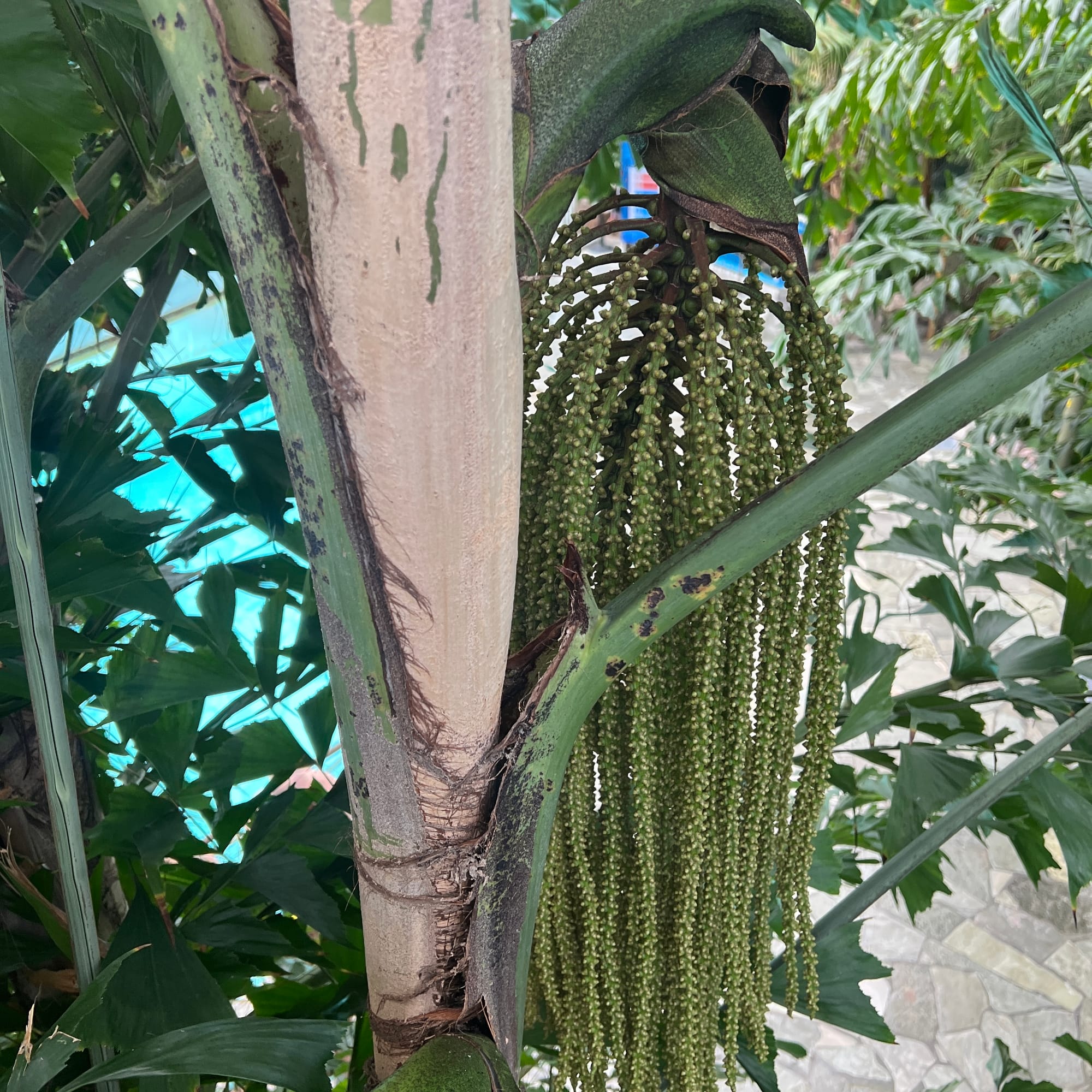
Caryota mitis
Contents
- Top Tips
- Location, Water, Humidity & Fertilisation
- Common Issues
- Origins, Temperature, Propagation, Repotting & Toxicity.
Need the answer to a specific plant query? Book a 1-to-1 video call with THE HOUSEPLANT DOCTOR™, the website's friendly author, to overcome and address your niggling problem! Available on iMessage, WhatsApp, Facebook Messenger & more.
Top Tips & Info
- Care Difficulty - Easy
- Bright, indirect light is key, with the possibility of an hour of winter sunlight to get it through the dormancy period.
- Allow the top third of the soil to dry out in between waters. It's recommended not to use the bottom-up method of submersion due to the risk of root rot.
- Provide a humid location away from operating radiators. Mist the foliage weekly or introduce a humidity tray over the colder months of the year.
- Fertilise using a 'Houseplant' or 'Palm' labelled feed every four waters in the spring and summer, reducing this to every six in the colder months.
- Repot every three years, using a 'Houseplant' labelled potting mix. Be sure to respect the roots as transplant shock is a big issue that may result in death in some cases.
- Keep an eye out for Spider Mites that'll locate themselves in webs along the ridges of the under-leaves.
Location & Light - 🔸🔸
Although bright, indirect sun is ideal, throw in some morning or evening sun during the height of winter. If it's situated in a shady location, wash the leaves from time to time to improve light-capturing efficiency by hosing it down outside. Never allow a Fishtail Palm to sit in strong sunlight for extended periods, as too much light will result in a pale, washed-out appearance with possible brown patches forming on the leaves.
Water - 🔸🔸
Allow the top third of the soil dry out in between irrigations during spring and summer, with monthly waters in the cooler months. If you're struggling to know when to water, feel the weight of the pot, and if it's lighter than when you last hydrated it, irrigation may be needed. Fishtail Palms are usually situated in a well-draining medium, meaning that standing water could be an issue beneath the pot. Under-watering symptoms include wilting, little to no growth and greying leaves - these issues are commonly down to too much light/heat, or forgetfulness. Alternatively, over-watering symptoms include rapidly yellowing lower leaves, wilting, brown spots on leaves and a rotten stem. Never situate this palm in dark locations with overly moist soil as root rot, and soil mould will quickly arise. For more information on how to address this issue, click on the appropriate links!
Humidity - 🔸🔸🔸
As Fishtail Palms originate from tropical regions in South East Asia, high humidity is mandatory for quality growth. You can achieve this by creating a humidity tray and locating it three metres or more away from an operating heater. A quick hose down once a month will hydrate the leaves, eliminate dust particles and help reduce numbers of pests, most notably spider mites.
Fertilisation - 🔸🔸
Feed every four waters during the growing period and every six in the autumn and winter, using a 'Houseplant' or 'Palm' labelled fertiliser. Never apply a 'ready to use’ product into the soil without a pre-water first, as it may burn the roots and lead to yellowed leaves.
Common Issues with Fishtail Palms
Regular irrigations are key. Periods of droughts will quickly slip the Fishtail Palm back into its dormancy period, causing stunted growth and a bewildered plant owner. If it hasn't repotted in a while, there may be too many roots and not enough soil to retain the moisture, thus leaving the soil to dry out quicker. Click on this link to learn more about a transplant.
Spider Mites are small, near-transparent critters, that'll slowly suck out the chlorophyll out of the leaves. Have a check under the leaves, most notably along the midrib, for small webs and gritty yellow bumps. Click here to read our article about the eradicating Spider Mites, along with some extra tips that you may not find elsewhere!
Too low humidity can cause browning leaf tips with yellow halos. Although this won't kill your specimen, you may want to increase the local moisture to prevent the new growth from adopting these symptoms. Mist or rinse the foliage from time to time and create a humidity tray whilst the heaters are active to create a stable environment for your specimen.
Dust the leaves regularly. Although this isn't too much of an issue, a build-up of dust particles can clog up the plant's pores, causing lowered light capturing-efficiency. Wipe the topsides of the leaves down once a month to keep levels down and improve growing conditions.
Yellowing leaves - it's difficult to accurately pinpoint why this is happening as it could be due to many different reasons. If the lower leaves are yellowing in quick concession, it may be over-watering. Do not allow the soil to become soil or waterlogged; failure to do so will cause root rot and possible death. For severe cases, take the plant out of rot pot to examine for root rot - a transplant may have to be performed. The second reason why its leaves are yellowing could be due to either too much sunlight or not enough water. As mentioned above, under-watering can cause a Fishtail Palm to slip into its dormancy period, but persistent droughts with direct sunlight will cause further damage in the likes of yellowing leaves, stunted growth and wilting.
Mould developing on the soil means two things - too little light and over-watering. Despite the harmlessness of the mould, it'll prove unsightly to most gardeners and is therefore removed once known. To remove, replace the top two inches of the soil for a fresh batch of 'Houseplant' compost. Either increase the amount of light received (no direct sunlight for the first few weeks to prevent environmental shock) or decrease the frequency of waters slightly. If the mould is accompanied by yellowing lower leaves, you may also have a case of root rot.
Origins
Caryota mitis is a species of flowering plants that originate from South Asia in tropical and semitropical locations, for example China or Java. It was first described back in 1790 by João de Loureiro during a visit to Vietnam. Its name derives from Ancient Greek, meaning 'dates' (fruits of Caryota) and the species' name, mitis, translating to 'gentle' in reference to the lack of thorns on the stems.
 The Distribution of Fishtail Palms
The Distribution of Fishtail Palms
Temperature
15° - 25°C (59° - 75°F)
H1a (Hardiness Zone 13) - Must be grown indoors or under glass all year round. Never allow temperatures to dip below 15℃ or permanent damage may occur in the likes of flower loss, stunted growth and yellowed leaves.
Spread
Most species won't grow above 2m in height (if grown in a pot) and 1m in width. The ultimate height will take between 5 - 10 years to achieve, with up to 20cm go growth put out per season.
Pruning & Maintenance
Remove crispy brown leaf tips and yellowing/dying fronds or leaflets (the individual leaf blades that make up the frond) to improve its overall appearance. While pruning, always use clean scissors or shears to reduce the chance of bacterial and fungal diseases. Remove any 'suckers' (distorted basal offshoots) from the soil as they yellow and die. Any fronds that develop brown spots and marks on its leaflets should also be pruned off, as the abnormality may develop across to other non-affected areas.
Note: Do not prune into stem as most indoor palms will only have a primary node and therefore won't be able to regrow.
Propagation
Via Seed & Division.
Basal Offset Division - Each individual stem will produce a basal offset that can be separated once it has a sufficient root system, and surpass 25cm (10 inches) in height. If possible, water the soil 24hrs before the main event to reduce the risk of transplant shock, when its dry root systems are over-fingered. Take the plant out of its pot and place your fingers close to the nodal junction - soil may have to be removed for better access. Push the chosen offset downwards until you hear a snap. Separate the foliage and its root system away from the mother plant, mentally noting the high risk of damage. Transplant in the appropriate sized pot with a fresh batch of 'Houseplant' soil. Maintain evenly moist soil and situate it in a bright, indirect location away from any direct sunlight. After ten weeks, treat it like a normal specimen, following the care tips above!
Flowers
Small panicles of red or purple flowers will appear in the spring or summer once the plant hits maturity in around eight years. If pollination is successful, the fleshy fruits will bare seeds in late summer that can be sown in the following spring after a mandatory dormancy period during the winter. Unfortunately, it's very rare for Fishtail Palms to bloom indoor due to the incorrect growing conditions.
 Caryota mitis (Fishtail Palms) has pendulous stems that'll hold over fifty flowers per 'branch', with its overall length reaching 40cm.
Caryota mitis (Fishtail Palms) has pendulous stems that'll hold over fifty flowers per 'branch', with its overall length reaching 40cm.
Repotting
Repot every three years in the spring, using a 'Houseplant' labelled and the next sized pot with adequate drainage. Hydrate the plant 24hrs before tinkering with the roots to prevent the risk of transplant shock. For those that are situated in a darker location, add a thin layer of small grit in the pot's base to improve drainage and downplay over-watering. Click here for a detailed step-by-step guide on transplantation, or via this link to learn about repotting with root rot.
Pests & Diseases
Keep an eye out for mealybugs, spider mites, scale, thrips, whitefly, vine weevils & root mealybugs that'll locate themselves in the cubbyholes and undersides of the leaves, except for the latter two which will be in the soil. Common diseases to look out for are root rot, leaf-spot disease, botrytis, powdery mildew & southern blight - click here to learn more about these issues.
Toxicity
This plant is classified as poisonous. If parts of the plants are digested, vomiting, nausea and a loss of appetite will occur. Consumption of larger quantities must be dealt with quickly, so acquire medical assistance for further information.
Retail Locations
Online Stores.
Book a 1-to-1 Call with THE HOUSEPLANT DOCTOR™
If you need further advice with your houseplants, book an advice call with ukhouseplants' friendly and expert writer today! This can be done via a video or audio call on most apps, including Facebook, FaceTime & Skype. A ten-minute call costs £5.99 (US$7), or £15.99 for thirty minutes. You can ask multiple questions, including queries on plants, pests, terrariums, repotting advice and anything in between. Please consider supporting this service to keep ukhouseplants thriving!